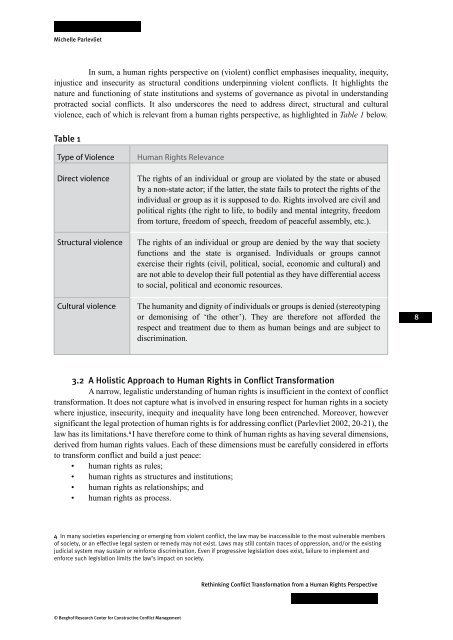Rethinking Conflict Transformation from a Human Rights Perspective
Rethinking Conflict Transformation from a Human Rights Perspective
Rethinking Conflict Transformation from a Human Rights Perspective
You also want an ePaper? Increase the reach of your titles
YUMPU automatically turns print PDFs into web optimized ePapers that Google loves.
Michelle Parlevliet<br />
In sum, a human rights perspective on (violent) conflict emphasises inequality, inequity,<br />
injustice and insecurity as structural conditions underpinning violent conflicts. It highlights the<br />
nature and functioning of state institutions and systems of governance as pivotal in understanding<br />
protracted social conflicts. It also underscores the need to address direct, structural and cultural<br />
violence, each of which is relevant <strong>from</strong> a human rights perspective, as highlighted in Table 1 below.<br />
Table 1<br />
Type of Violence <strong>Human</strong> <strong>Rights</strong> Relevance<br />
Direct violence The rights of an individual or group are violated by the state or abused<br />
by a non-state actor; if the latter, the state fails to protect the rights of the<br />
individual or group as it is supposed to do. <strong>Rights</strong> involved are civil and<br />
political rights (the right to life, to bodily and mental integrity, freedom<br />
<strong>from</strong> torture, freedom of speech, freedom of peaceful assembly, etc.).<br />
Structural violence The rights of an individual or group are denied by the way that society<br />
functions and the state is organised. Individuals or groups cannot<br />
exercise their rights (civil, political, social, economic and cultural) and<br />
are not able to develop their full potential as they have differential access<br />
to social, political and economic resources.<br />
Cultural violence The humanity and dignity of individuals or groups is denied (stereotyping<br />
or demonising of ‘the other’). They are therefore not afforded the<br />
respect and treatment due to them as human beings and are subject to<br />
discrimination.<br />
3.2 A Holistic Approach to <strong>Human</strong> <strong>Rights</strong> in <strong>Conflict</strong> <strong>Transformation</strong><br />
A narrow, legalistic understanding of human rights is insufficient in the context of conflict<br />
transformation. It does not capture what is involved in ensuring respect for human rights in a society<br />
where injustice, insecurity, inequity and inequality have long been entrenched. Moreover, however<br />
significant the legal protection of human rights is for addressing conflict (Parlevliet 2002, 20-21), the<br />
law has its limitations. 4 I have therefore come to think of human rights as having several dimensions,<br />
derived <strong>from</strong> human rights values. Each of these dimensions must be carefully considered in efforts<br />
to transform conflict and build a just peace:<br />
• human rights as rules;<br />
• human rights as structures and institutions;<br />
• human rights as relationships; and<br />
• human rights as process.<br />
4 In many societies experiencing or emerging <strong>from</strong> violent conflict, the law may be inaccessible to the most vulnerable members<br />
of society, or an effective legal system or remedy may not exist. Laws may still contain traces of oppression, and/or the existing<br />
judicial system may sustain or reinforce discrimination. Even if progressive legislation does exist, failure to implement and<br />
enforce such legislation limits the law’s impact on society.<br />
© Berghof Research Center for Constructive <strong>Conflict</strong> Management<br />
<strong>Rethinking</strong> <strong>Conflict</strong> <strong>Transformation</strong> <strong>from</strong> a <strong>Human</strong> <strong>Rights</strong> <strong>Perspective</strong><br />
8
















